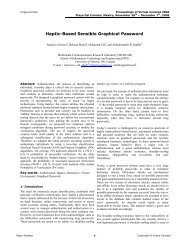Part-based PCA for Facial Feature Extraction and Classification
Part-based PCA for Facial Feature Extraction and Classification
Part-based PCA for Facial Feature Extraction and Classification
You also want an ePaper? Increase the reach of your titles
YUMPU automatically turns print PDFs into web optimized ePapers that Google loves.
vertical position of the eyebrows as H1; set the second wave<br />
trough that corresponds to the vertical position of the eyes as<br />
H2. The starting vertical position of the eyes area is H1-<br />
0.2 × VH, where VH=H2-H1; while the ending vertical<br />
position is H2+0.8× VH. Here, we get the extracted eyes area<br />
shown in Fig 8.<br />
Fig 5. Integral projection curves<br />
If we rotate the projection curve 90 degree, aligning the<br />
image with its vertical position, we could detect the position<br />
of eyes <strong>and</strong> mouth region by observing the horizontal graylevel<br />
projection curves. In horizontal gray-level integral<br />
projection, wave troughs of previous features are <strong>for</strong>med on<br />
the curves of the graphs due to the majority of black color in<br />
the areas of eyebrows, eyes, <strong>and</strong> mouths. By observing the<br />
wave trough, we could locate the position of the eyes <strong>and</strong><br />
mouth areas. In horizontal gray-level projection, from the left<br />
to the right, the first minimum value represents the position<br />
of the eyebrow; the second minimum value represents the<br />
position of the eye. From the right to the left, the first<br />
minimum value represents the position of the mouth. Fig 6<br />
shows the position of the eyebrows, eyes <strong>and</strong> mouth.<br />
Fig 8. The extracted eyes area<br />
We apply the same method <strong>for</strong> mouth area detection. Suppose<br />
the vertical length of the face image is H. Set the first wave<br />
trough from the top after 0.7H as H4, <strong>and</strong> the closest wave<br />
trough above H4 as H3. The starting vertical position of the<br />
mouth area is H3+0.4 × VH, where VH=H4-H3; while the<br />
ending vertical position is H4+0.7× VH. The extracted mouth<br />
area is shown in Fig 9.<br />
Fig 6. The position of the eyebrows, eyes <strong>and</strong> mouth<br />
However, due to image complexity <strong>and</strong> noise, there might be<br />
some small wave trough in the projection curve, which<br />
interferes with eyes <strong>and</strong> mouth location detection. There<strong>for</strong>e,<br />
we need to smoothen the integral projection curves, filter<br />
minor wave troughs, <strong>and</strong> eliminate disturbing in<strong>for</strong>mation.<br />
After smoothening, there will be four main wave troughs<br />
appearing, which represent eyebrows, eyes, nose <strong>and</strong> mouth<br />
respectively, see Fig 7.<br />
Fig 9. The extracted mouth area<br />
Based on the extracted eyes <strong>and</strong> mouth areas, we still need to<br />
refine the extracted eyes <strong>and</strong> mouth areas <strong>for</strong> future Gabor<br />
trans<strong>for</strong>mation. We apply integral projection once more with<br />
vertical projection. The vertical projection curves of eyes <strong>and</strong><br />
mouth areas are shown in the following figure:<br />
Fig 7. Horizontal projection after smoothening<br />
The detail steps to detect eyes areas are: Considering the<br />
vertical length of the face image is H. Set the first wave<br />
trough from the top after 0.15H that corresponds to the<br />
Fig 10. Vertical projection curves of eyes <strong>and</strong> mouth areas<br />
The final extracted eyes area is the range from the left most<br />
maximum value W1 to the right most maximum value W2<br />
(see Fig 11); while the final extracted mouth area is between:<br />
the right most maximum value W1 from the middle to the left<br />
<strong>and</strong> the left most maximum value W2 from the middle to the<br />
right (see Fig 12).<br />
102






